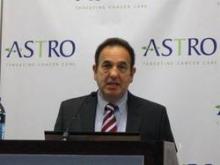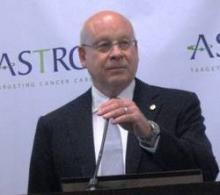User login
American Society for Radiation Oncology (ASTRO): Annual Meeting
Quality-of-life difference may explain poorer survival after high-dose lung irradiation
ATLANTA – In patients undergoing radiation therapy for locally advanced non–small cell lung cancer, quality-of-life scores were more predictive of overall survival than were tumor stage or performance status, Dr. Benjamin Movsas reported at the annual meeting of the American Society for Radiation Oncology.
Among patients in the RTOG 0617 trial, every baseline increase of 10 points on a validated lung cancer quality-of-life scale was associated with a 14% reduction in the risk of death. In multivariate analysis, neither performance status nor tumor stage significantly predicted overall survival, whereas quality-of-life scores did, said Dr. Movsas, chairman of radiation oncology at the Henry Ford Health System in Detroit.
Results of the RTOG 0617 trial, reported at the 2011 ASTRO annual meeting, indicated that higher radiation doses did not improve overall survival. At 1 year, median overall survival was 81% for patients randomized to treatment with standard-dose (60-Gy) radiation and 70.4% for those who received high-dose (74-Gy) radiation. The respective median survival rates were 21.7 months and 20.7 months (P = .02).
The high-dose arm of the study was stopped in June 2011 when a planned interim analysis showed that the radiation comparison had crossed the prespecified boundary for futility.
"Why was the survival actually lower in patients who received the higher dose of radiation? When we look at the toxicity, as scored by the physicians, there were few if any differences," Dr. Movsas noted in a press briefing prior to his presentation of the data in a plenary session.
To answer that question, researchers looked at patient-reported quality-of-life data from RTOG 0617, which was collected at baseline, 3 months from the start of treatment, and again at 12 months using the FACT-TOI (Functional Assessment of Cancer Therapy–Trial Outcome Index). The index comprises items touching on physical and functional well-being, as well as a lung cancer subscale. Clinically meaningful changes are a point change of 2 or more on each of the subscales, and a point change of 5 or more on the overall scale.
Patients who received the higher radiation dose had clinically meaningful declines in quality-of-life scores on the lung cancer subscale at 3 months compared with baseline. The decrease was 46% among patients in the high-dose arm and 31% in the standard-dose arm (P = .024). At 12 months, however, the changes over baseline were not significantly different at 39% and 36%, respectively.
"Beyond the radiation level, the baseline quality of life also predicted for survival, as well as in multivariate analysis," Dr. Movsas said.
Although the study was not randomized by treatment type, intensity-modulated radiation therapy (IMRT) was used in 41% of patients who received the 60-Gy dose and who completed quality-of-life evaluations, and in 44% of patients who received 74 Gy and completed the evaluations. The remaining patients in each group received 3D conformal radiation therapy.
Significantly more patients with stage IIIB disease and larger gross tumor volumes were treated with IMRT. Nonetheless, there was a trend at 3 months toward a smaller decline in quality of life at 3 months (43% for 3D vs. 31% for IMRT; P = .06) and a significant difference at 12 months (47% vs. 23%; P = .005).
"Despite few differences in provider-reported toxicity between the arms, the patient-reported outcomes help tell us at least part of the rest of the story by showing significantly worse quality of life on the high-dose arm at 3 months, confirming the quality-of-life hypothesis," Dr. Movsas said.
The finding "raises the intriguing question of whether the decline in quality of life on the high-dose arm may help account for the survival decrement in this arm over time," he added.
The researchers are also looking at other factors that might account for the survival difference, including the volume of the heart irradiated and local failure rates.
A radiation oncologist who was not involved in the study said that it emphasizes the importance of collecting and analyzing patient-outcomes data.
Although the study’s primary endpoint showed that dose escalation did not improve outcomes, "we find out as a secondary analysis that patients who received intensity-modulated radiation therapy, which spares normal tissues, had a better quality of life," said Dr. Bruce G. Haffty, a radiation oncologist at the Cancer Institute of New Jersey in New Brunswick, and ASTRO president-elect.
Dr. Haffty moderated the briefing in which Dr. Movsas discussed his data.
RTOG 0617 was supported by the National Cancer Institute. Dr. Movsas disclosed departmental research support from Varian and Philips. Dr. Haffty reported having no relevant disclosures.
ATLANTA – In patients undergoing radiation therapy for locally advanced non–small cell lung cancer, quality-of-life scores were more predictive of overall survival than were tumor stage or performance status, Dr. Benjamin Movsas reported at the annual meeting of the American Society for Radiation Oncology.
Among patients in the RTOG 0617 trial, every baseline increase of 10 points on a validated lung cancer quality-of-life scale was associated with a 14% reduction in the risk of death. In multivariate analysis, neither performance status nor tumor stage significantly predicted overall survival, whereas quality-of-life scores did, said Dr. Movsas, chairman of radiation oncology at the Henry Ford Health System in Detroit.
Results of the RTOG 0617 trial, reported at the 2011 ASTRO annual meeting, indicated that higher radiation doses did not improve overall survival. At 1 year, median overall survival was 81% for patients randomized to treatment with standard-dose (60-Gy) radiation and 70.4% for those who received high-dose (74-Gy) radiation. The respective median survival rates were 21.7 months and 20.7 months (P = .02).
The high-dose arm of the study was stopped in June 2011 when a planned interim analysis showed that the radiation comparison had crossed the prespecified boundary for futility.
"Why was the survival actually lower in patients who received the higher dose of radiation? When we look at the toxicity, as scored by the physicians, there were few if any differences," Dr. Movsas noted in a press briefing prior to his presentation of the data in a plenary session.
To answer that question, researchers looked at patient-reported quality-of-life data from RTOG 0617, which was collected at baseline, 3 months from the start of treatment, and again at 12 months using the FACT-TOI (Functional Assessment of Cancer Therapy–Trial Outcome Index). The index comprises items touching on physical and functional well-being, as well as a lung cancer subscale. Clinically meaningful changes are a point change of 2 or more on each of the subscales, and a point change of 5 or more on the overall scale.
Patients who received the higher radiation dose had clinically meaningful declines in quality-of-life scores on the lung cancer subscale at 3 months compared with baseline. The decrease was 46% among patients in the high-dose arm and 31% in the standard-dose arm (P = .024). At 12 months, however, the changes over baseline were not significantly different at 39% and 36%, respectively.
"Beyond the radiation level, the baseline quality of life also predicted for survival, as well as in multivariate analysis," Dr. Movsas said.
Although the study was not randomized by treatment type, intensity-modulated radiation therapy (IMRT) was used in 41% of patients who received the 60-Gy dose and who completed quality-of-life evaluations, and in 44% of patients who received 74 Gy and completed the evaluations. The remaining patients in each group received 3D conformal radiation therapy.
Significantly more patients with stage IIIB disease and larger gross tumor volumes were treated with IMRT. Nonetheless, there was a trend at 3 months toward a smaller decline in quality of life at 3 months (43% for 3D vs. 31% for IMRT; P = .06) and a significant difference at 12 months (47% vs. 23%; P = .005).
"Despite few differences in provider-reported toxicity between the arms, the patient-reported outcomes help tell us at least part of the rest of the story by showing significantly worse quality of life on the high-dose arm at 3 months, confirming the quality-of-life hypothesis," Dr. Movsas said.
The finding "raises the intriguing question of whether the decline in quality of life on the high-dose arm may help account for the survival decrement in this arm over time," he added.
The researchers are also looking at other factors that might account for the survival difference, including the volume of the heart irradiated and local failure rates.
A radiation oncologist who was not involved in the study said that it emphasizes the importance of collecting and analyzing patient-outcomes data.
Although the study’s primary endpoint showed that dose escalation did not improve outcomes, "we find out as a secondary analysis that patients who received intensity-modulated radiation therapy, which spares normal tissues, had a better quality of life," said Dr. Bruce G. Haffty, a radiation oncologist at the Cancer Institute of New Jersey in New Brunswick, and ASTRO president-elect.
Dr. Haffty moderated the briefing in which Dr. Movsas discussed his data.
RTOG 0617 was supported by the National Cancer Institute. Dr. Movsas disclosed departmental research support from Varian and Philips. Dr. Haffty reported having no relevant disclosures.
ATLANTA – In patients undergoing radiation therapy for locally advanced non–small cell lung cancer, quality-of-life scores were more predictive of overall survival than were tumor stage or performance status, Dr. Benjamin Movsas reported at the annual meeting of the American Society for Radiation Oncology.
Among patients in the RTOG 0617 trial, every baseline increase of 10 points on a validated lung cancer quality-of-life scale was associated with a 14% reduction in the risk of death. In multivariate analysis, neither performance status nor tumor stage significantly predicted overall survival, whereas quality-of-life scores did, said Dr. Movsas, chairman of radiation oncology at the Henry Ford Health System in Detroit.
Results of the RTOG 0617 trial, reported at the 2011 ASTRO annual meeting, indicated that higher radiation doses did not improve overall survival. At 1 year, median overall survival was 81% for patients randomized to treatment with standard-dose (60-Gy) radiation and 70.4% for those who received high-dose (74-Gy) radiation. The respective median survival rates were 21.7 months and 20.7 months (P = .02).
The high-dose arm of the study was stopped in June 2011 when a planned interim analysis showed that the radiation comparison had crossed the prespecified boundary for futility.
"Why was the survival actually lower in patients who received the higher dose of radiation? When we look at the toxicity, as scored by the physicians, there were few if any differences," Dr. Movsas noted in a press briefing prior to his presentation of the data in a plenary session.
To answer that question, researchers looked at patient-reported quality-of-life data from RTOG 0617, which was collected at baseline, 3 months from the start of treatment, and again at 12 months using the FACT-TOI (Functional Assessment of Cancer Therapy–Trial Outcome Index). The index comprises items touching on physical and functional well-being, as well as a lung cancer subscale. Clinically meaningful changes are a point change of 2 or more on each of the subscales, and a point change of 5 or more on the overall scale.
Patients who received the higher radiation dose had clinically meaningful declines in quality-of-life scores on the lung cancer subscale at 3 months compared with baseline. The decrease was 46% among patients in the high-dose arm and 31% in the standard-dose arm (P = .024). At 12 months, however, the changes over baseline were not significantly different at 39% and 36%, respectively.
"Beyond the radiation level, the baseline quality of life also predicted for survival, as well as in multivariate analysis," Dr. Movsas said.
Although the study was not randomized by treatment type, intensity-modulated radiation therapy (IMRT) was used in 41% of patients who received the 60-Gy dose and who completed quality-of-life evaluations, and in 44% of patients who received 74 Gy and completed the evaluations. The remaining patients in each group received 3D conformal radiation therapy.
Significantly more patients with stage IIIB disease and larger gross tumor volumes were treated with IMRT. Nonetheless, there was a trend at 3 months toward a smaller decline in quality of life at 3 months (43% for 3D vs. 31% for IMRT; P = .06) and a significant difference at 12 months (47% vs. 23%; P = .005).
"Despite few differences in provider-reported toxicity between the arms, the patient-reported outcomes help tell us at least part of the rest of the story by showing significantly worse quality of life on the high-dose arm at 3 months, confirming the quality-of-life hypothesis," Dr. Movsas said.
The finding "raises the intriguing question of whether the decline in quality of life on the high-dose arm may help account for the survival decrement in this arm over time," he added.
The researchers are also looking at other factors that might account for the survival difference, including the volume of the heart irradiated and local failure rates.
A radiation oncologist who was not involved in the study said that it emphasizes the importance of collecting and analyzing patient-outcomes data.
Although the study’s primary endpoint showed that dose escalation did not improve outcomes, "we find out as a secondary analysis that patients who received intensity-modulated radiation therapy, which spares normal tissues, had a better quality of life," said Dr. Bruce G. Haffty, a radiation oncologist at the Cancer Institute of New Jersey in New Brunswick, and ASTRO president-elect.
Dr. Haffty moderated the briefing in which Dr. Movsas discussed his data.
RTOG 0617 was supported by the National Cancer Institute. Dr. Movsas disclosed departmental research support from Varian and Philips. Dr. Haffty reported having no relevant disclosures.
AT THE ASTRO ANNUAL MEETING
Major finding: Clinically meaningful declines from baseline lung cancer quality-of-life subscale scores at 3 months were 46% in patients treated with 74 Gy and 31% in patients treated with 60 Gy (P = .024).
Data source: Analysis of prospective data on quality of life from the RTOG 0617 trial.
Disclosures: RTOG 0617 was supported by the National Cancer Institute. Dr. Movsas disclosed departmental research support from Varian and Philips. Dr. Haffty reported having no relevant disclosures.
ASTRO outlines five radiation oncology practices that should be curtailed
ATLANTA – Five common radiation therapy practices are not adequately supported by evidence and may not be the best choice for many patients, radiation oncology experts said at the annual meeting of the American Society for Radiation Oncology (ASTRO).
The evidence-based recommendations on radiation therapy for breast cancer, prostate cancer, and bone metastases are part of the national "Choosing Wisely" campaign, which is aimed at improving the quality of care by reducing or eliminating overuse of tests and procedures. This campaign is about "removal of waste to improve quality and safety, and doing no harm to patients," said Daniel Wolfson, executive vice president and chief operating officer of the American Board of Internal Medicine (ABIM) Foundation, which is leading the Choosing Wisely campaign.
Medical societies in various disciplines have released recommendations geared toward individual clinical disciplines, and now it’s ASTRO’s turn, said Dr. Michael L. Steinberg, chairman of ASTRO’s board of directors, in a briefing announcing the guidelines. "The list serves only as a starting point for a detailed conversation between a patient and physician, and to ensure patient-centered care, which is a core principle of ASTRO."
The five recommendations are:
• Don’t initiate whole-breast radiotherapy as a part of breast conservation therapy in women aged 50 years and older with early-stage invasive breast cancer without considering shorter treatment schedules.
"We’ve known for years that whole-breast radiation improves local control and improves survival, and has cosmetic advantages over mastectomy," Dr. Steinberg said. In recent years, however, randomized clinical trials have demonstrated that shorter courses of therapy – less than 4 weeks, compared with 5 weeks for conventionally fractionated radiation – produce equivalent tumor control and cosmetic outcomes.
• Don’t initiate management of patients who have low-risk prostate cancer without discussing active surveillance.
Patients with low-risk prostate cancer should discuss "reasonable management options" with their physicians, including active surveillance. With this recommendation, ASTRO is "reinforcing the shared decision-making model," Dr. Steinberg said.
• Don’t routinely use extended fractionation schemes (more than 10 fractions) for palliation of bone metastases.
Patients with bone metastases may derive equivalent pain relief from 30 Gy in 10 fractions, 20 Gy over 5 fractions, or even a single 8-Gy fraction, studies suggest. The single-fraction option is more convenient for patients, but it may be associated with a marginally higher need for retreatment of the same site. Patients who are not ambulatory, have transportation problems, or a limited prognosis may be good candidates for the single-fraction option, the guidelines say.
• Don’t routinely recommend proton-beam therapy for prostate cancer outside of a prospective clinical trial or registry.
"There is no clear evidence that proton-beam therapy for prostate cancer offers any clinical advantage over other forms of definitive radiation therapy. Clinical trials are necessary to establish a possible advantage of this expensive therapy," the Choosing Wisely guidelines state.
At ASTRO 2012, investigators reported that men who receive proton-beam radiotherapy for prostate cancer have modestly better bowel function in the short term than do those who receive conformal or intensity-modulated radiation, but the effect is transient. In addition, proton-beam therapy is estimated to cost about 70% more than external-beam radiotherapy for the treatment of prostate cancer.
• Don’t routinely use intensity-modulated radiation therapy (IMRT) to deliver whole-breast radiotherapy as part of breast conservation therapy.
"Clinical trials have suggested lower rates of skin toxicity after using modern 3D conformal techniques relative to older methods of 2D planning. In these trials, the term ‘IMRT’ has generally been applied to describe methods that are more accurately defined as field-in-field 3D conformal radiotherapy. While IMRT may be of benefit in select cases where the anatomy is unusual, its routine use has not been demonstrated to provide significant clinical advantage," the guidelines note.
The cost difference between 3D conformal radiotherapy and IMRT for whole-breast radiotherapy is approximately $7,000, according to Dr. Steinberg.
"These are not ‘never do this’ recommendations, these are ‘engage the patient in the shared-decision paradigm’ guidelines, because there may be patients that are better treated with, let’s say, IMRT [for whole-breast radiotherapy]," he said.
Asked whether the Choosing Wisely guidelines in radiation oncology and other disciplines might be used by insurers to justify denying reimbursement for certain procedures, Mr. Wolfson said that "we haven’t seen that, and whether it comes to be will be the question, but we would sharply criticize that [approach]."
ATLANTA – Five common radiation therapy practices are not adequately supported by evidence and may not be the best choice for many patients, radiation oncology experts said at the annual meeting of the American Society for Radiation Oncology (ASTRO).
The evidence-based recommendations on radiation therapy for breast cancer, prostate cancer, and bone metastases are part of the national "Choosing Wisely" campaign, which is aimed at improving the quality of care by reducing or eliminating overuse of tests and procedures. This campaign is about "removal of waste to improve quality and safety, and doing no harm to patients," said Daniel Wolfson, executive vice president and chief operating officer of the American Board of Internal Medicine (ABIM) Foundation, which is leading the Choosing Wisely campaign.
Medical societies in various disciplines have released recommendations geared toward individual clinical disciplines, and now it’s ASTRO’s turn, said Dr. Michael L. Steinberg, chairman of ASTRO’s board of directors, in a briefing announcing the guidelines. "The list serves only as a starting point for a detailed conversation between a patient and physician, and to ensure patient-centered care, which is a core principle of ASTRO."
The five recommendations are:
• Don’t initiate whole-breast radiotherapy as a part of breast conservation therapy in women aged 50 years and older with early-stage invasive breast cancer without considering shorter treatment schedules.
"We’ve known for years that whole-breast radiation improves local control and improves survival, and has cosmetic advantages over mastectomy," Dr. Steinberg said. In recent years, however, randomized clinical trials have demonstrated that shorter courses of therapy – less than 4 weeks, compared with 5 weeks for conventionally fractionated radiation – produce equivalent tumor control and cosmetic outcomes.
• Don’t initiate management of patients who have low-risk prostate cancer without discussing active surveillance.
Patients with low-risk prostate cancer should discuss "reasonable management options" with their physicians, including active surveillance. With this recommendation, ASTRO is "reinforcing the shared decision-making model," Dr. Steinberg said.
• Don’t routinely use extended fractionation schemes (more than 10 fractions) for palliation of bone metastases.
Patients with bone metastases may derive equivalent pain relief from 30 Gy in 10 fractions, 20 Gy over 5 fractions, or even a single 8-Gy fraction, studies suggest. The single-fraction option is more convenient for patients, but it may be associated with a marginally higher need for retreatment of the same site. Patients who are not ambulatory, have transportation problems, or a limited prognosis may be good candidates for the single-fraction option, the guidelines say.
• Don’t routinely recommend proton-beam therapy for prostate cancer outside of a prospective clinical trial or registry.
"There is no clear evidence that proton-beam therapy for prostate cancer offers any clinical advantage over other forms of definitive radiation therapy. Clinical trials are necessary to establish a possible advantage of this expensive therapy," the Choosing Wisely guidelines state.
At ASTRO 2012, investigators reported that men who receive proton-beam radiotherapy for prostate cancer have modestly better bowel function in the short term than do those who receive conformal or intensity-modulated radiation, but the effect is transient. In addition, proton-beam therapy is estimated to cost about 70% more than external-beam radiotherapy for the treatment of prostate cancer.
• Don’t routinely use intensity-modulated radiation therapy (IMRT) to deliver whole-breast radiotherapy as part of breast conservation therapy.
"Clinical trials have suggested lower rates of skin toxicity after using modern 3D conformal techniques relative to older methods of 2D planning. In these trials, the term ‘IMRT’ has generally been applied to describe methods that are more accurately defined as field-in-field 3D conformal radiotherapy. While IMRT may be of benefit in select cases where the anatomy is unusual, its routine use has not been demonstrated to provide significant clinical advantage," the guidelines note.
The cost difference between 3D conformal radiotherapy and IMRT for whole-breast radiotherapy is approximately $7,000, according to Dr. Steinberg.
"These are not ‘never do this’ recommendations, these are ‘engage the patient in the shared-decision paradigm’ guidelines, because there may be patients that are better treated with, let’s say, IMRT [for whole-breast radiotherapy]," he said.
Asked whether the Choosing Wisely guidelines in radiation oncology and other disciplines might be used by insurers to justify denying reimbursement for certain procedures, Mr. Wolfson said that "we haven’t seen that, and whether it comes to be will be the question, but we would sharply criticize that [approach]."
ATLANTA – Five common radiation therapy practices are not adequately supported by evidence and may not be the best choice for many patients, radiation oncology experts said at the annual meeting of the American Society for Radiation Oncology (ASTRO).
The evidence-based recommendations on radiation therapy for breast cancer, prostate cancer, and bone metastases are part of the national "Choosing Wisely" campaign, which is aimed at improving the quality of care by reducing or eliminating overuse of tests and procedures. This campaign is about "removal of waste to improve quality and safety, and doing no harm to patients," said Daniel Wolfson, executive vice president and chief operating officer of the American Board of Internal Medicine (ABIM) Foundation, which is leading the Choosing Wisely campaign.
Medical societies in various disciplines have released recommendations geared toward individual clinical disciplines, and now it’s ASTRO’s turn, said Dr. Michael L. Steinberg, chairman of ASTRO’s board of directors, in a briefing announcing the guidelines. "The list serves only as a starting point for a detailed conversation between a patient and physician, and to ensure patient-centered care, which is a core principle of ASTRO."
The five recommendations are:
• Don’t initiate whole-breast radiotherapy as a part of breast conservation therapy in women aged 50 years and older with early-stage invasive breast cancer without considering shorter treatment schedules.
"We’ve known for years that whole-breast radiation improves local control and improves survival, and has cosmetic advantages over mastectomy," Dr. Steinberg said. In recent years, however, randomized clinical trials have demonstrated that shorter courses of therapy – less than 4 weeks, compared with 5 weeks for conventionally fractionated radiation – produce equivalent tumor control and cosmetic outcomes.
• Don’t initiate management of patients who have low-risk prostate cancer without discussing active surveillance.
Patients with low-risk prostate cancer should discuss "reasonable management options" with their physicians, including active surveillance. With this recommendation, ASTRO is "reinforcing the shared decision-making model," Dr. Steinberg said.
• Don’t routinely use extended fractionation schemes (more than 10 fractions) for palliation of bone metastases.
Patients with bone metastases may derive equivalent pain relief from 30 Gy in 10 fractions, 20 Gy over 5 fractions, or even a single 8-Gy fraction, studies suggest. The single-fraction option is more convenient for patients, but it may be associated with a marginally higher need for retreatment of the same site. Patients who are not ambulatory, have transportation problems, or a limited prognosis may be good candidates for the single-fraction option, the guidelines say.
• Don’t routinely recommend proton-beam therapy for prostate cancer outside of a prospective clinical trial or registry.
"There is no clear evidence that proton-beam therapy for prostate cancer offers any clinical advantage over other forms of definitive radiation therapy. Clinical trials are necessary to establish a possible advantage of this expensive therapy," the Choosing Wisely guidelines state.
At ASTRO 2012, investigators reported that men who receive proton-beam radiotherapy for prostate cancer have modestly better bowel function in the short term than do those who receive conformal or intensity-modulated radiation, but the effect is transient. In addition, proton-beam therapy is estimated to cost about 70% more than external-beam radiotherapy for the treatment of prostate cancer.
• Don’t routinely use intensity-modulated radiation therapy (IMRT) to deliver whole-breast radiotherapy as part of breast conservation therapy.
"Clinical trials have suggested lower rates of skin toxicity after using modern 3D conformal techniques relative to older methods of 2D planning. In these trials, the term ‘IMRT’ has generally been applied to describe methods that are more accurately defined as field-in-field 3D conformal radiotherapy. While IMRT may be of benefit in select cases where the anatomy is unusual, its routine use has not been demonstrated to provide significant clinical advantage," the guidelines note.
The cost difference between 3D conformal radiotherapy and IMRT for whole-breast radiotherapy is approximately $7,000, according to Dr. Steinberg.
"These are not ‘never do this’ recommendations, these are ‘engage the patient in the shared-decision paradigm’ guidelines, because there may be patients that are better treated with, let’s say, IMRT [for whole-breast radiotherapy]," he said.
Asked whether the Choosing Wisely guidelines in radiation oncology and other disciplines might be used by insurers to justify denying reimbursement for certain procedures, Mr. Wolfson said that "we haven’t seen that, and whether it comes to be will be the question, but we would sharply criticize that [approach]."
EXPERT ANALYSIS FROM THE ASTRO ANNUAL MEETING





